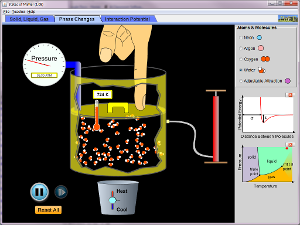2. Why hold students accountable for the stations/centers? This is necessary, especially in the beginning of the school year, to let students know they have a task to complete and this task will be checked for completion. Otherwise, a set of headphones or a computer screen turned away from view becomes a music and facebook activity.
3. Two interactive links and how they could be used as stations. LOVE LOVE the PhET site - this could easily be set up as traveling stations. The site even allows you to embed the interactive to reinforce use of the blog to the students.
Position the 6 netbooks, have a different activity at each one, and partners have to travel between these 6 activities. Our interactive notebooks are a great tool to use to monitor and track student accountability. This can either be a free entry to show participation (better to allow this type of entry after the school year is underway and students are aware of teacher expectations) or there can be a guided outline which students are required to complete. There could also be some preset blog questions or Grouply entries that students are asked to complete at each station.
Simultaneously, students can use the macbooks to log in to Grouply to update their daily blog, posting observations while creating their question-of-the-day for classmates to complete.
The second link that I found interesting was Interactivate. This has many additional activities that hit on specific topics and reinforce key objectives.
4. iPad apps for the classroom stations: GoSkyWatch is very cool. Shows realtime placement of stars and planets, which would be very useful during our astronomy unit. Students could be assigned a specific constellation or planet and would have report it's position at the time at which they are viewing. The NASA app also has great aspects - allows students to see planetary data, track movements and more.
5. Other ways to use the iPad as a station - there are many interactive sites which could be easily implemented. QUIA, GIZMO and independent Brainpop activities are just a few. The apps that would be relevant to each particular topic are numerous. The key will be making these relevant as well as having a way to keep the student accountable for their participation.
With regards to Sir Ken Robinson.......there is no doubt - we DO need to change what we do to fit the needs of our current students.....not only is the overall culture different today than when I started teaching a large number of years ago, but that culture is forming a different student, and bringing a completely new cherub to the classroom than those who we taught using methods which worked so many years ago.
It wasn't an all bad way to teach. . . we were teaching from a blackboard, with students frantically copying notes and completing an array of handouts . . . but then again, a 13 channel TV with a turn knob to change channels and two wires to increase reception was not an all bad way to be entertained. And yet we have easily welcomed our entertainment change, with no one complaining about having to leave the large console behind as they move to the flat screen, HDTV which provides hundreds of channels that can be changed from a sitting position and occasionally supports a set of glasses that makes the screen come right to you. I find it interesting how we as teachers sometimes have difficulty leaving behind our chalk and erasers to move to something that is new and effective to help our students become more successful.


No comments:
Post a Comment